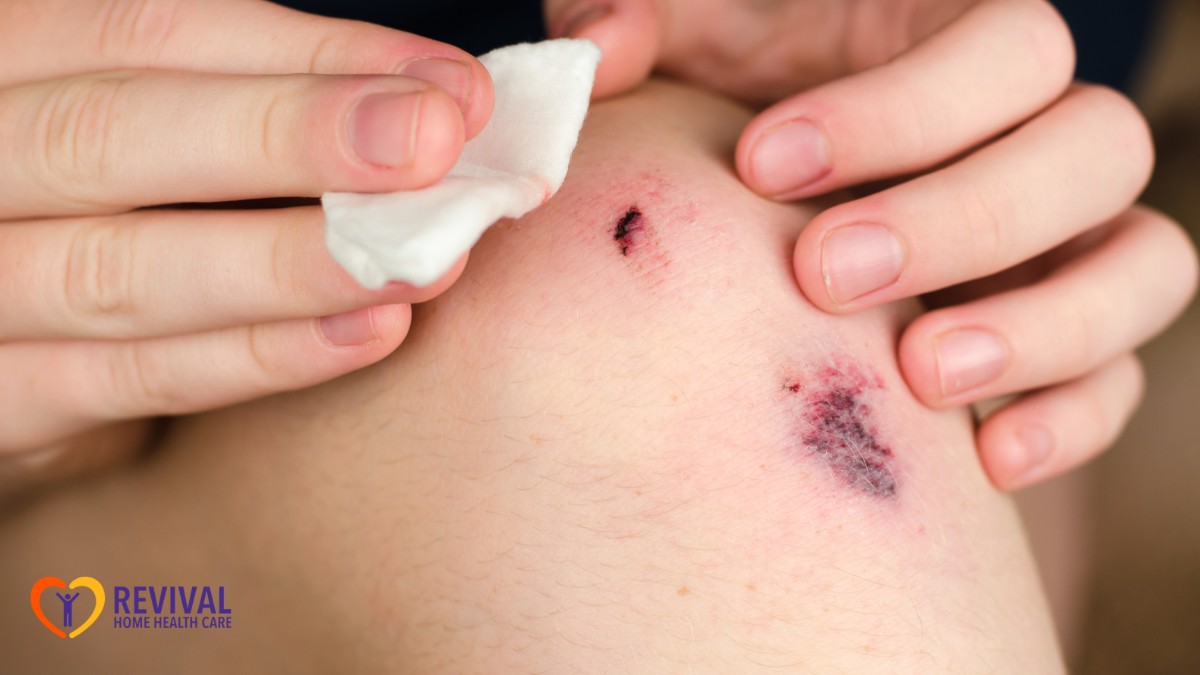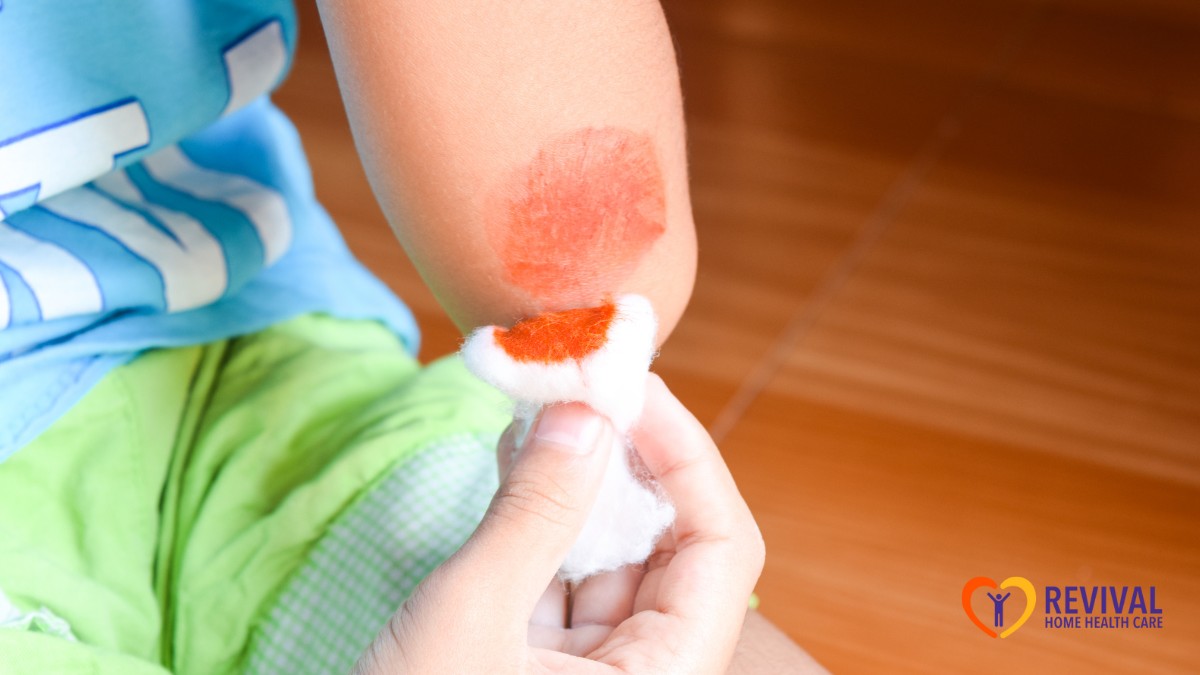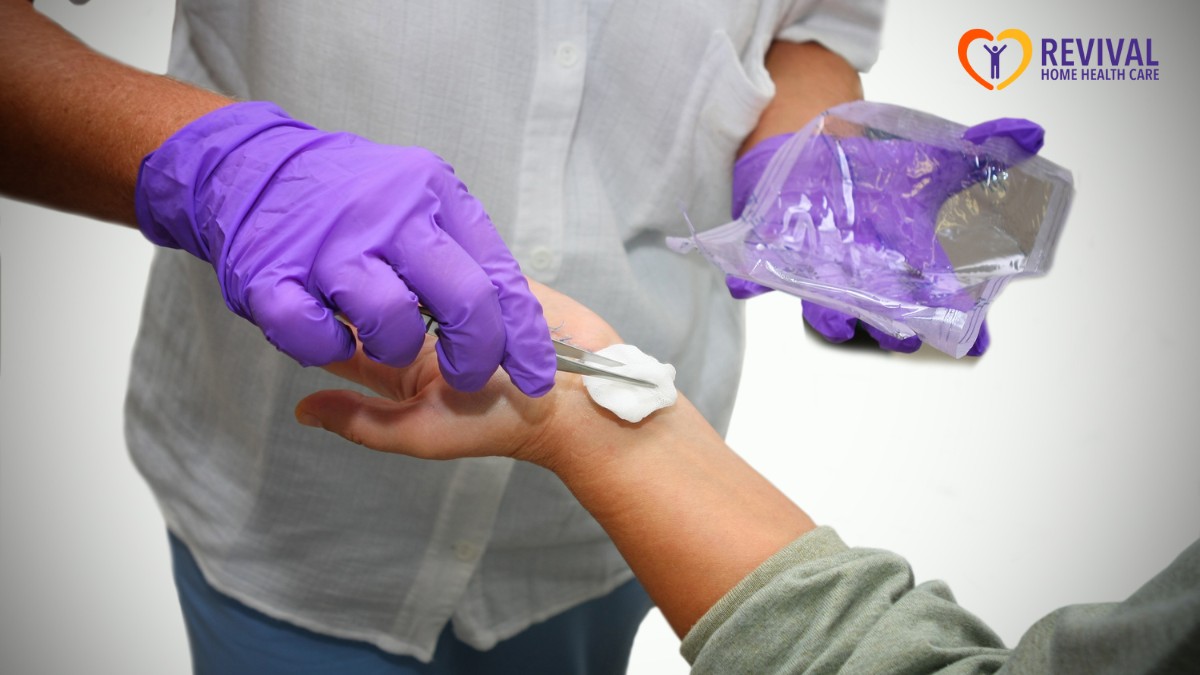Key Points:
- Providing at-home wound care involves cleanliness, observation, and ongoing support to ensure proper healing.
- Family caregivers play a critical role in preventing infection, managing supplies, and monitoring progress.
- Knowing when to seek professional help is essential for avoiding complications and supporting recovery.
Caring for a loved one with a wound at home can feel like a big responsibility. You want to help, but it’s easy to feel unsure about how to manage wound care properly. This guide walks you through how to confidently care for wounds at home—safely, compassionately, and with the peace of mind that you’re doing the right thing. Whether you’re just starting or looking to improve your routine, we’ll explore practical steps to support healing and comfort.

Understanding the Basics of At-Home Wound Care
When helping a loved one heal from a wound, knowing the basics sets the foundation for proper care. Let’s begin with what wound care at home actually involves.
What Is At-Home Wound Care?
At-home wound care refers to treating and managing open cuts, surgical incisions, pressure ulcers, or chronic wounds outside a clinical setting. This care typically includes cleaning, dressing, monitoring, and supporting the healing process in a clean, safe environment.
Whether it’s a surgical site after discharge or a chronic condition like a diabetic ulcer, home-based care reduces hospital stays and helps patients recover in familiar surroundings.
Why Good Wound Care Matters
Even small wounds can become serious if not properly cared for. Infections, delayed healing, and discomfort can arise without a consistent care plan. That’s why daily observation, cleanliness, and proper dressing are so important in managing wounds effectively at home.
Preparing Your Space and Supplies
Before touching a wound, make sure your environment and tools are ready. This section explains how to set up a clean and organized wound care area at home.
Creating a Clean Care Area
Choose a quiet, well-lit spot in your home to perform wound care—ideally near a sink for handwashing. Clear away clutter, disinfect surfaces, and keep pets or distractions away during care.
Lay down clean towels or disposable pads to create a sanitary workspace. Having a routine area helps reduce germs and maintain consistency.
Essential Supplies for Wound Care
Keep all supplies together in a clean, labeled container or drawer. Common items may include:
- Sterile gloves
- Gauze pads and medical tape
- Antiseptic solution or wound cleanser
- Moisturizers or prescribed ointments
- Scissors (disinfected before each use)
- Waste bags for used materials
Your healthcare provider will guide you on what’s appropriate for your loved one’s specific wound type.
Performing Daily Wound Care: Step-by-Step
Consistency and proper technique are the key to success in at-home wound management. Here’s how to perform wound care safely and confidently.
Step 1: Wash Your Hands and Use Gloves
Begin by ensuring excellent hand hygiene. Wash your hands carefully with soap and warm water, scrubbing for at least 20 seconds. To minimize germ transfer, put on clean, single-use gloves.
If gloves aren’t an option, be certain your hands are thoroughly washed and be mindful not to touch other things while you’re taking care of someone.
Step 2: Remove the Old Dressing Gently
Carefully peel away the old dressing. If it sticks, moisten it with saline to avoid damaging the healing skin. Discard it in a sealed bag along with used gloves.
Look at the wound closely and note any unusual signs like foul odors, increased redness, or pus, which may indicate infection.
Step 3: Clean the Wound
Use a prescribed wound cleanser or sterile saline to gently irrigate the area. Avoid using alcohol or hydrogen peroxide unless directed, as these can delay healing.
Use a sterile gauze pad to gently pat the area dry, working from the center of the wound outward to avoid spreading bacteria.
Step 4: Apply Medication or Ointments
If prescribed, apply a thin layer of topical medication or ointment using a sterile applicator or clean-gloved hand. Follow your provider’s instructions on application frequency and amount.
This step helps fight infection and keeps the wound moist to support tissue repair.
Step 5: Apply a New Dressing
Place a clean, sterile dressing over the wound. Secure it with medical tape or a wrap that allows airflow but keeps the wound protected.
Check for signs of pressure or discomfort after applying the dressing. Dressings should be snug but not too tight.

Recognizing Signs of Infection or Delayed Healing
As a caregiver, it’s essential to watch for signs that a wound isn’t healing properly. These early warnings can help prevent serious complications.
Common Signs of Infection
Call a healthcare provider if you notice any of the following:
- Redness spreading beyond the wound
- Swelling or warmth around the area
- Increased pain
- Yellow or green discharge
- Fever or chills
Prompt treatment can help avoid hospitalization and support faster recovery.
When Healing Slows Down
Wounds that don’t show improvement within a week or two—especially chronic or diabetic wounds—may need additional medical intervention. Contact your care team if the wound size stays the same, worsens, or starts to smell. Don’t wait too long to ask for help; early intervention is key.
Offering Emotional and Practical Support
Wound care isn’t just physical—it affects your loved one emotionally too. Your support can make a real difference in their healing journey.
Provide Encouragement and Comfort
Your loved one may feel embarrassed, frustrated, or discouraged about their condition. Reassure them often, especially during uncomfortable dressing changes. Speak calmly and offer encouragement throughout the process.
It helps to maintain a sense of routine and dignity, especially for elderly patients or those with mobility limitations.
Help With Related Daily Tasks
Wound care might interfere with bathing, dressing, or sleeping. Offer assistance with hygiene, comfortable clothing, and restful sleep positions that avoid pressure on the wound.
Using a shower chair or waterproof dressing covers can also make daily routines easier.
Keeping a Wound Care Log
Tracking your care routine helps ensure consistency and provides valuable insights to share with your loved one’s medical team.
Here are some important things to record:
- Date and time of each dressing change
- Description of wound appearance
- Any new symptoms or changes
- Medication or dressing used
- Notes on pain levels
A simple notebook or digital app can keep all your observations in one place for easy reference during follow-up appointments.

When to Seek Professional Help
Even the most attentive caregiver will occasionally need extra support. Don’t hesitate to contact a healthcare provider when:
- The wound becomes larger or deeper
- Pain increases or becomes unmanageable
- There’s a sudden change in appearance
- You feel unsure about the proper care steps
Nurses or wound care specialists can visit the home, offer advanced treatments, or adjust the care plan as needed.
Make Healing at Home Safer and More Supportive
Helping a loved one with at-home wound care is an act of patience and love. While it may feel intimidating at first, your role makes a powerful impact on recovery and comfort. With the right supplies, daily routines, and knowledge of warning signs, you can create a safe and healing environment in the place they feel most secure—home.
Contact Revival for In-Home Wound Care in New York
Support your loved one’s recovery with expert help you can trust.
If you’re managing wound care at home and need extra support, Revival offers compassionate home health services in New York. Our experienced professionals work alongside family caregivers to ensure safe, effective, and personalized treatment in the comfort of home.
Get in touch with us today to learn how we can help you navigate wound care with confidence and care.


 75 Vanderbilt Ave Staten Island, NY 10304
75 Vanderbilt Ave Staten Island, NY 10304 info@revivalhhc.org
info@revivalhhc.org 718.629.1000
718.629.1000